Key takeaways:
- Ocean conservation is essential for protecting marine ecosystems and supporting local communities reliant on these resources.
- Coral reefs are critical for marine biodiversity; their degradation leads to ecosystem collapse and affects food security.
- Challenges such as pollution, overfishing, and climate change threaten hidden reefs, necessitating urgent conservation actions.
- Personal involvement in conservation efforts, like beach cleanups and coral restoration, fosters a sense of responsibility and inspires wider community awareness.
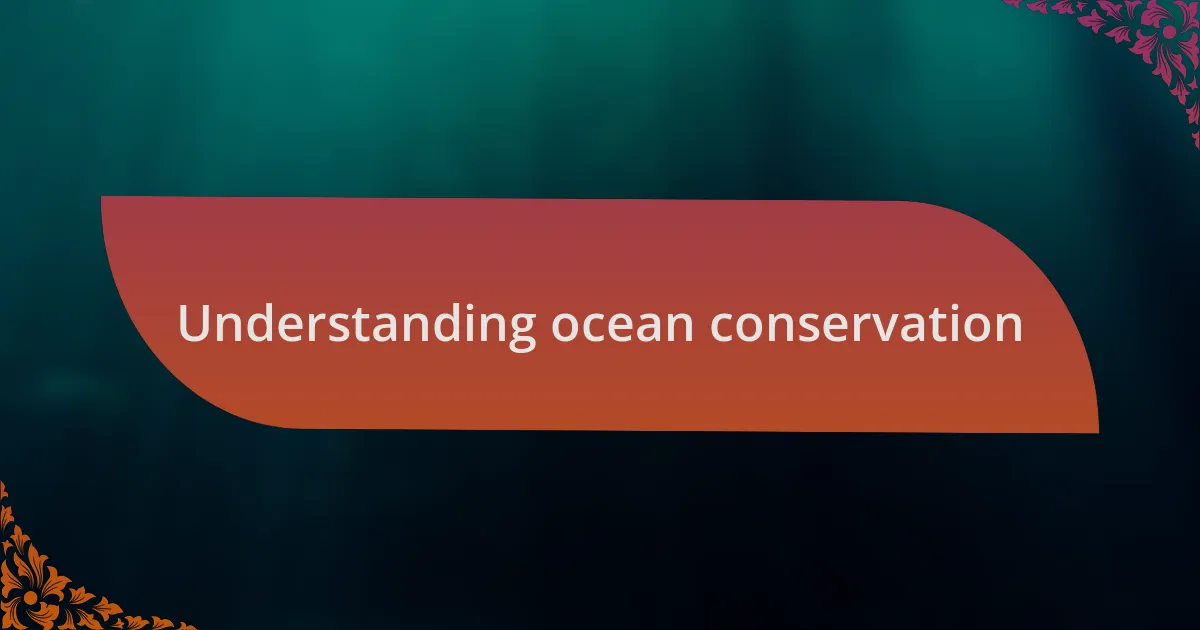
Understanding ocean conservation
Ocean conservation is vital for maintaining the health of our planet. Every time I dive into the ocean, I’m amazed by its beauty, yet I’m also struck by the fragility of its ecosystems. Have you ever wondered what happens to the sea life when coral reefs are damaged? Their decline not only affects marine creatures but also disrupts entire food webs and local communities depending on these resources.
One day, while exploring a hidden reef, I stumbled upon a vibrant underwater world teeming with life. I felt a deep sense of connection, and it struck me just how crucial our role is in protecting these habitats. It made me realize that conservation efforts must focus on protecting these ecosystems from pollution and climate change. How can we stand by while our oceans are threatened?
Additionally, supporting sustainable fishing practices can make a significant difference. When I learned about the overfishing that devastates fish populations and local livelihoods, it hit home. It’s not just about protecting the species; it’s about preserving the cultural and economic identity of coastal communities. What kind of future do we envision for ourselves if we ignore these pressing issues?
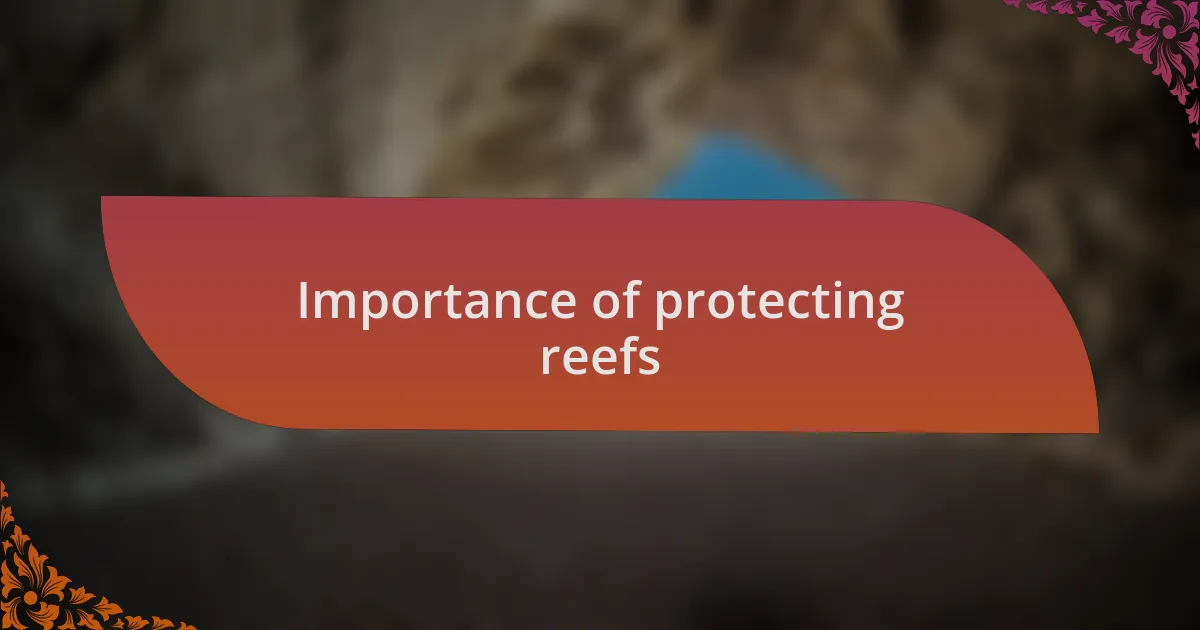
Importance of protecting reefs
The health of coral reefs is crucial for marine biodiversity. During my explorations, I often observe how various species rely on these reefs for shelter, food, and reproduction. When I see a broken coral structure, I can’t help but think—what lives are lost due to our inaction? Protecting these reefs is essential because their destruction not only erases beauty but also diminishes the rich tapestry of life in the ocean.
I’ve felt the impact of degraded reefs firsthand while snorkeling in areas once vibrant with activity. The stark difference in marine life left me pondering how fragile these ecosystems are. What happens when we lose such habitat? The answer is dire: the collapse of entire ecosystems, leading to a decline in fish populations and, ultimately, affecting food security for many communities. It’s a heartbreaking realization that drives my passion for reef conservation.
When I engage with local populations, I’m often reminded of the stories they share about the reef’s role in their lives. They tell me about generations that have thrived because of these ecosystems. So, I ask myself—if we ignore the importance of protecting reefs, what legacy are we leaving for future generations? It’s this sense of responsibility that fuels my commitment to advocacy and action for ocean conservation.
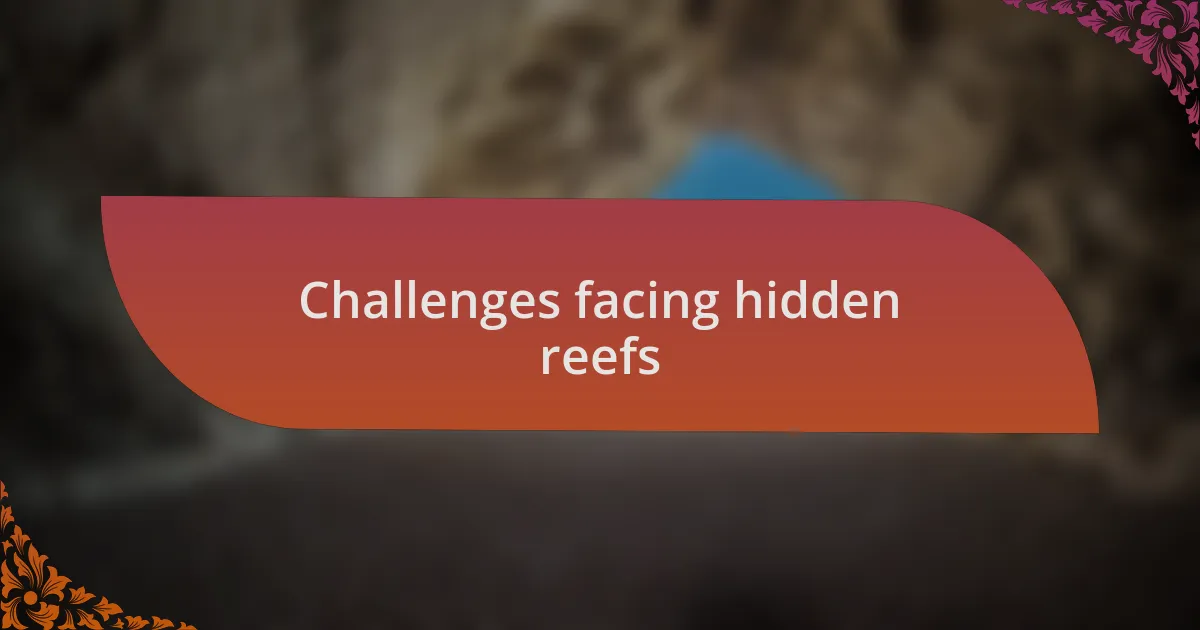
Challenges facing hidden reefs
Hidden reefs face a myriad of challenges, often becoming victims of the very beauty they provide. During one of my snorkeling trips, I was struck by the patches of bleached coral, a stark reminder of coral bleaching caused by rising water temperatures and pollution. It left me wondering, how many more underwater paradises will we lose if we don’t take urgent action?
In my conversations with marine biologists, a recurring theme is the impact of human activities on these reefs. Overfishing is a significant threat, disrupting the balance of marine life that thrives around hidden reefs. I remember watching a fisher haul in countless juveniles, their future as part of the reef system cut short. How can we expect these ecosystems to survive if the very species that sustain them are being depleted?
Additionally, the challenge of climate change weighs heavily on hidden reefs. I recall finding a reef that once buzzed with life—now eerily quiet, its inhabitants seemed to have disappeared. This reality prompts me to ask: if we continue to ignore our role in this process, can we truly justify our love for the ocean? The answer is a resounding no. Each lost species represents a fragment of a complex web that, without careful stewardship, may unravel before our eyes.
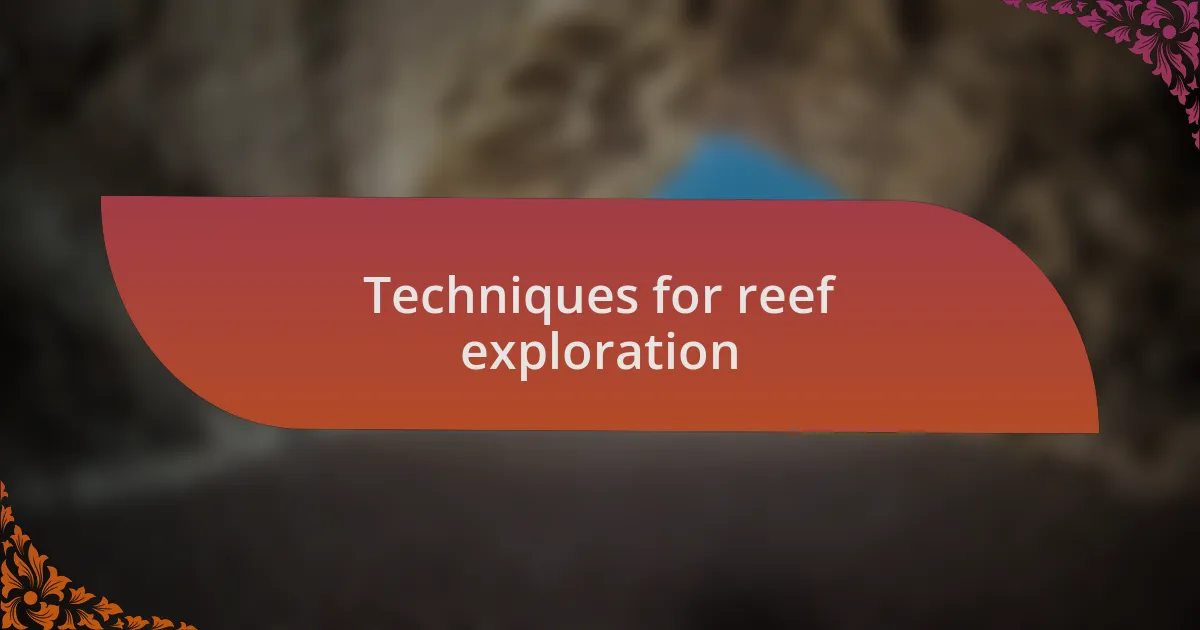
Techniques for reef exploration
Exploring hidden reefs requires a blend of traditional techniques and modern technology. During one of my dives, I relied on a handheld underwater camera to capture the vibrant life surrounding the coral formations. By documenting the biodiversity directly, I could later reflect on my findings, connecting the dots between the visual evidence and the threats these ecosystems face. Isn’t it fascinating how these images can tell the story of a reef’s health?
Using sonar mapping has revolutionized our understanding of these submerged landscapes. I remember accompanying a team that utilized sonar to identify uncharted reefs, revealing complex structures that were previously hidden. It was like uncovering a treasure map! The three-dimensional views provided crucial insights into where coral growth thrives and where it is struggling, allowing us to strategize more effective conservation efforts. How often do we overlook the hidden potential of technology in marine exploration?
Following a systematic approach can also be essential. On my last trip, I joined a group that implemented a grid survey technique to monitor specific reef areas meticulously. This technique not only helped us track changes over time but also allowed us to measure the impact of human activities on different sections of the reef. The sense of purpose in knowing that our data collection could contribute to future conservation strategies was incredibly rewarding. Could there be a more meaningful way to interact with such delicate ecosystems?
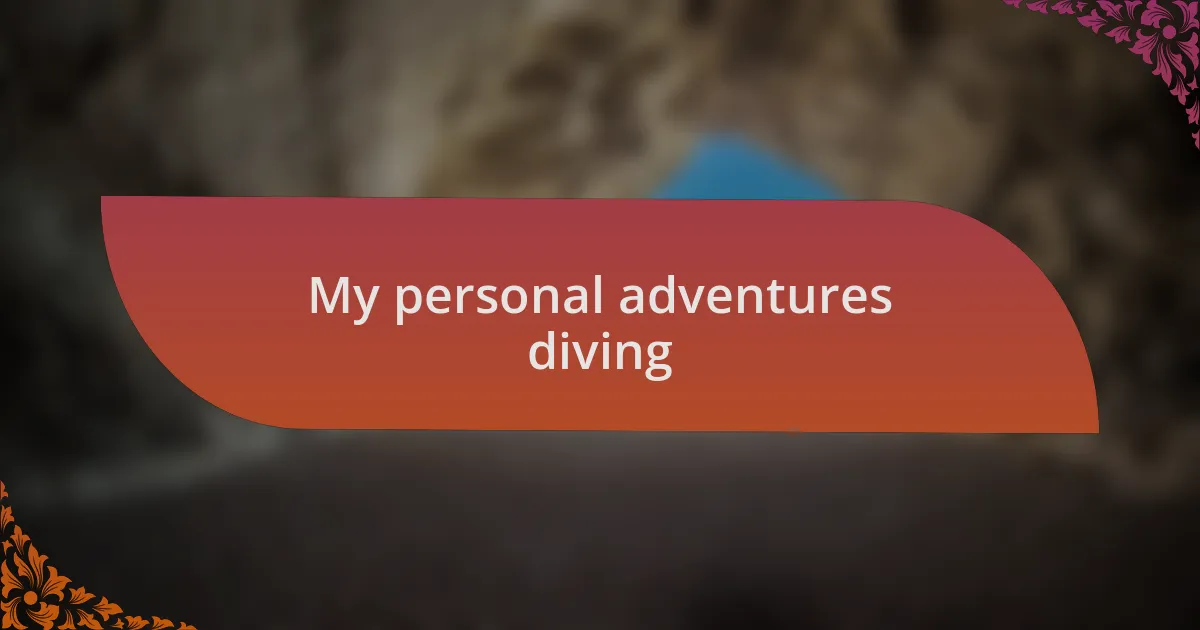
My personal adventures diving
Diving into the azure depths has always been a transformative experience for me. One vivid memory stands out from a day spent exploring a secluded reef off the coast of Belize. As I descended, I felt a rush of exhilaration and curiosity. The water enveloped me, and suddenly, I was surrounded by a kaleidoscope of colors from the corals, and schools of fish darted past like shimmering jewels. How could something so breathtaking coexist quietly beneath the surface?
On another occasion, I had the chance to dive near a reef that had recently suffered from a bleaching event. As I swam through the stark white patches where vibrant coral used to thrive, a mix of sadness and determination washed over me. It was a poignant reminder of the fragility of these ecosystems. Witnessing this firsthand deepened my commitment to marine conservation. Every dive reinforces my belief: our underwater world needs our protection now more than ever.
When exploring shallow lagoons, I discovered the joy of encountering unusual marine life, like the elusive seahorse. Watching it sway gently with the current felt like a private moment between me and nature. Each dive presents new opportunities for connection and discovery, reminding me that there’s so much still to explore. Isn’t diving not just about the sights, but about forging bonds with the ocean and understanding its heartbeat?
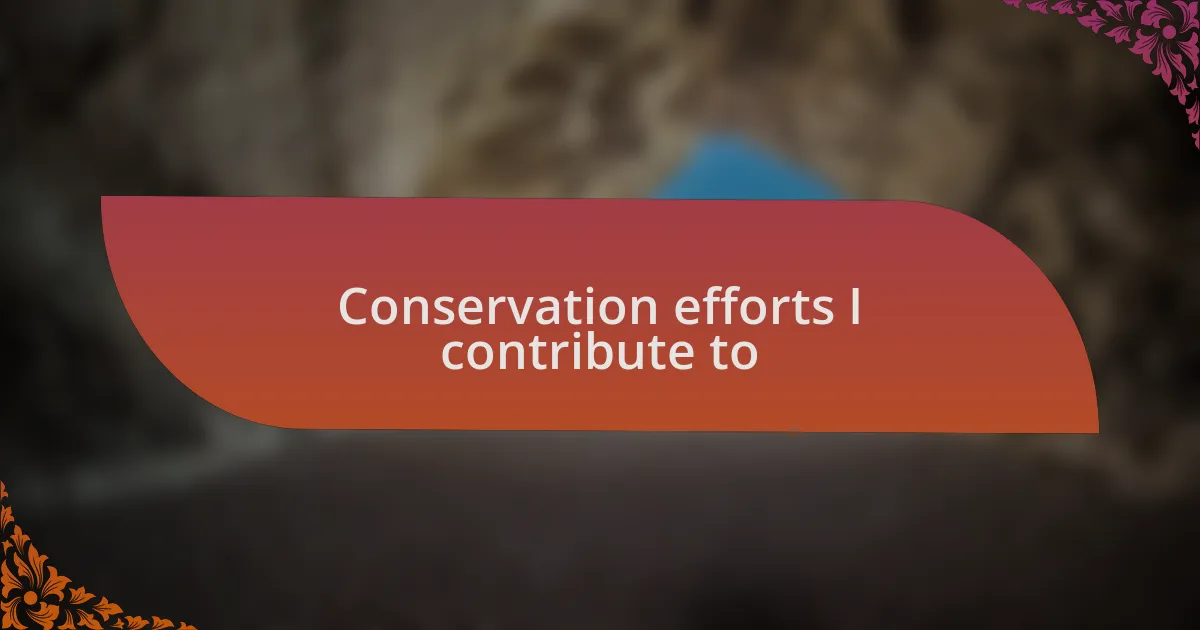
Conservation efforts I contribute to
Conservation efforts aren’t just an abstract concept for me; they’re woven into the fabric of my diving experiences. For instance, after each dive, I make it a point to participate in beach cleanups in the local community. There’s something incredibly satisfying about picking up debris that could harm marine life, and it truly feels like I’m giving back to the ocean that has given me so much joy.
I also actively support initiatives focused on coral restoration. I remember the first time I got involved—I ankle-deep in salty water, planting small coral fragments in designated areas. The thrill of knowing I was contributing to the revival of a damaged reef was palpable. Every little effort counts, and seeing even a few new corals thriving gives me hope for the future.
Moreover, I advocate for sustainable practices by sharing my diving experiences on social media, prompting friends and followers to rethink their own habits. When I post about the impact of single-use plastics on ocean ecosystems, I often wonder how many lives might be changed by just one article or post. It’s all about fostering awareness, and if I can ignite even a spark of curiosity in someone else, I feel that my passion for conservation has a wider ripple effect.
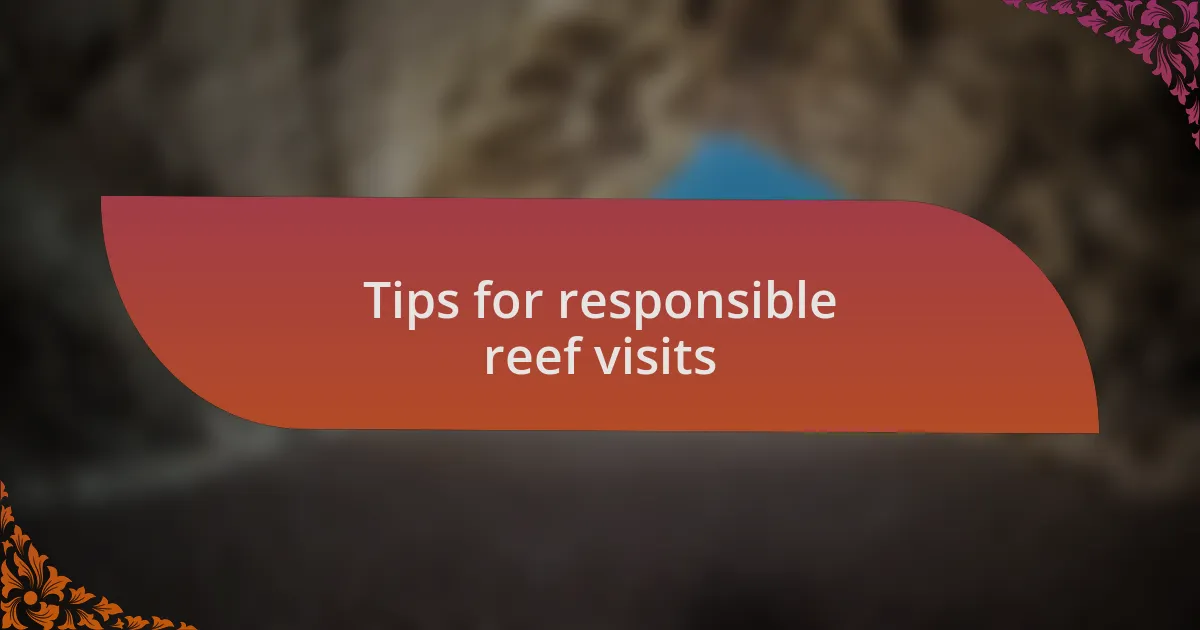
Tips for responsible reef visits
When exploring hidden reefs, I always prioritize my impact on the environment. Before I dive in, I make it a point to educate myself about local regulations and guidelines—after all, knowing what to do and what to avoid helps preserve these precious ecosystems. Have you ever wondered how simple actions can ripple outward? Trust me, doing a little homework can go a long way in ensuring these reefs remain vibrant for future generations.
One of my favorite practices is choosing to dive with eco-friendly tour operators. I remember a particular outing where our guides emphasized the importance of not touching corals, showcasing how sensitive they are to disturbance. It struck me how even a brief contact could have lasting consequences. Supporting businesses that value conservation not only enhances my experience but also strengthens the collective effort to protect our oceans.
Additionally, I always carry a reusable bag to collect any trash I find while snorkeling or swimming. It’s astonishing how a small gesture can spark conversations with fellow divers. I find myself turning to my friends and asking, “Have you ever considered what you could do in just a few minutes?” It’s moments like these that reveal the shared responsibility we all hold in safeguarding the marine life that captivates us.